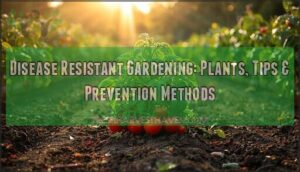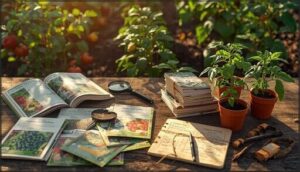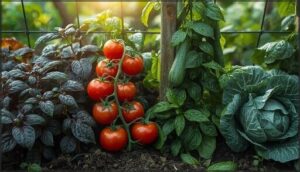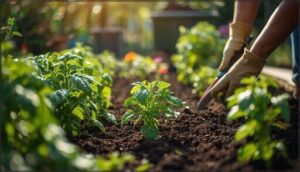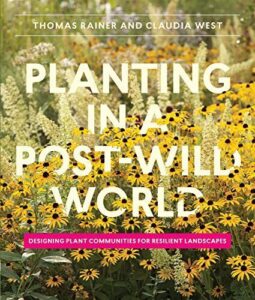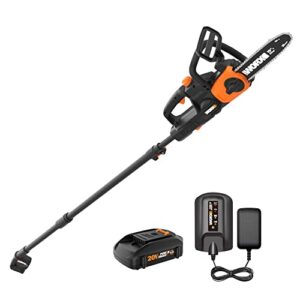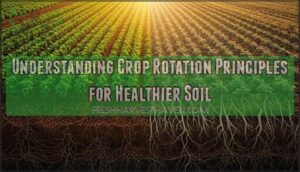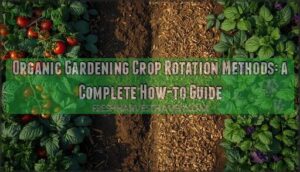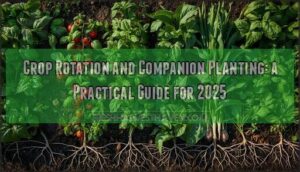This site is supported by our readers. We may earn a commission, at no cost to you, if you purchase through links.
Every gardener knows the frustration: you nurture a tomato plant from seed, watch it grow strong through summer, and then a disease shows up and destroys it in days. But here’s what most gardeners don’t realize—your plants actually have their own immune system, and you can use it.
Disease resistant gardening isn’t about spraying chemicals or getting lucky. It’s about working with your plants’ natural defenses to stop problems before they start. When you grow disease resistant varieties and combine them with smart gardening practices, you can cut disease pressure by half or more.
The payoff goes beyond just healthier plants: you’ll spend less on treatments, get bigger harvests, and create a garden that thrives with less struggle. Let’s dig into how to build a garden that fights back.
Table Of Contents
- Key Takeaways
- Key Principles of Disease Resistant Gardening
- Selecting and Growing Resistant Plant Varieties
- Top Disease-Resistant Plants for Gardens
- Effective Strategies for Preventing Plant Diseases
- Top Tools and Books for Disease Resistant Gardening
- Frequently Asked Questions (FAQs)
- What is an example of a disease resistant plant?
- What vegetables don’t get blight?
- How to get rid of disease in garden soil?
- How to make plants disease resistant?
- How do companion plants help prevent diseases?
- What natural fungicides work for organic gardens?
- When should diseased plants be completely removed?
- How does soil pH affect disease resistance?
- Can overwatering make plants more disease-prone?
- What soil amendments boost natural disease resistance?
- Conclusion
Key Takeaways
- You can cut disease pressure in half by choosing varieties with built-in resistance genes (look for codes like “V” for verticillium or “F” for fusarium in seed catalogs) and pairing them with smart spacing, proper watering, and healthy soil.
- Disease resistance doesn’t mean your plants are bulletproof—resistant varieties still need good practices like drip irrigation, 3-year crop rotation, and quick removal of infected plants to stay strong when conditions favor pathogens.
- Healthy soil acts like your garden’s immune system, with compost boosting beneficial microbes by 42% and organic mulch cutting disease rates by 30% while stabilizing temperature swings that stress plants.
- Early morning watering and proper plant spacing (which drops humidity 5-8 percentage points between leaves) stop most fungal diseases before they start, since pathogens need 8-14 hours of leaf wetness to take hold.
Key Principles of Disease Resistant Gardening
Not all plants are created equal when it comes to fighting off diseases. Understanding how resistance actually works can help you make smarter choices in your garden and avoid common mistakes that trip up even experienced gardeners.
Let’s consider the science behind disease-resistant plants, what you gain by growing them, and the real-world limitations you should know about.
How Disease Resistance Works in Plants
Your plants have a built-in defense system that kicks in when disease resistance genes detect trouble. Think of it as your garden’s security team, with multiple layers working together:
Plants possess built-in defense layers that activate when disease resistance genes detect pathogen threats
- Pattern-triggered immunity spots invaders first, cutting pathogen colonization by over 50%
- Effector-triggered immunity launches targeted attacks through specialized resistance genes
- Systemic resistance spreads protection throughout the entire plant after initial infection
These natural mechanisms make resistant varieties genuinely tougher against plant pathogens. Researchers are working to understand effector triggered immunity to develop durable disease management strategies.
Benefits of Growing Resistant Varieties
Growing disease-resistant plants delivers real rewards you’ll notice season after season. Here’s what you gain:
| Benefit | Impact | Your Garden Win |
|---|---|---|
| Yield stability | 15-25% more harvest | Predictable bounces from your beds |
| Reduced pesticides | 30-60% fewer sprays | Safer soil and water |
| Economic advantages | $10-$150 return per $1 | Lower costs, better profits |
| Environmental impact | 40% less chemical load | Healthier ecosystem balance |
These resistant varieties strengthen food security while protecting beneficial insects and pollinators naturally. Disease resistance stems from a plant’s genetic ability to prevent pathogens.
Common Myths and Limitations
Despite those wins, you need to understand what resistance truly means—and what it doesn’t guarantee. Let’s clear up three stubborn myths:
- Resistance doesn’t equal immunity – Even scab-resistant ‘Prairiefire’ crabapples can show symptoms during very wet springs when pathogen pressure spikes.
- Resistant varieties still need good practices – Poor spacing and overhead watering invite disease regardless of plant genetics.
- Resistance can fail over time – Pathogen populations evolve, sometimes overcoming previously reliable resistance within five years.
Environmental overrides matter too. Extended leaf wetness, high inoculum levels, or nitrogen overfertilization can overwhelm your plant’s defenses. And remember, disease-specific resistance means a tomato that shrugs off verticillium wilt might still succumb to powdery mildew.
Management impacts never disappear—resistant plants thrive best when you combine them with crop rotation, sanitation, and smart watering.
Selecting and Growing Resistant Plant Varieties
Choosing the right plants is half the battle when you’re aiming for a disease-resistant garden. You’ll need to know how to spot resistant varieties in seed catalogs, understand the trade-offs between hybrids and heirlooms, and pick plants that actually thrive in your specific growing conditions.
Let’s break down each of these steps so you can make smart choices from the start.
Identifying Disease-Resistant Plants in Catalogs
Seed catalogues can feel like puzzles with their cryptic codes, but cracking the system is easier than you think. Look for the disease resistance legend—usually tucked at the front or within each crop section. Those abbreviations, like “V” for verticillium wilt or “F” for fusarium, reveal which varieties stand strong against specific threats.
Most catalogs distinguish high resistance (HR) from intermediate resistance (IR), so you’ll know what to expect under heavy disease pressure. Tomatoes often carry stacked codes like “VFFNTA,” packing protection against multiple soilborne diseases into one plant. Understanding HR/IR helps you set realistic expectations—even highly resistant varieties can show symptoms when conditions favor pathogens.
Crop-specific coding makes matching varieties to your garden’s history simple. If fusarium struck your tomatoes last year, scan for “F” or “F1–2” in catalog listings. Cucumbers and lettuce use different virus codes, like LMV or CVYV, adapted to regional pressures. Catalog legends translate these shorthand markers, turning confusing letters into actionable intel.
Practical selection means prioritizing varieties with multiple resistance codes when catalogs present similar options. Choosing disease-resistant varieties becomes straightforward once you cross-check catalog resistance codes against your documented problems. Selecting disease-resistant plants this way protects your harvest without guesswork.
| Code | What It Means |
|---|---|
| V | Verticillium wilt resistance |
| F or FF | Fusarium wilt (races 1 and/or 2) |
| N | Root-knot nematode tolerance |
| T | Tobacco mosaic virus protection |
Hybrid Vs. Heirloom: Pros and Cons
You’ll want to weigh trade-offs when choosing between hybrids and heirlooms, since each brings distinct strengths to your garden.
- Yield Comparison: Hybrids generally produce more uniform fruit and higher overall yields than heirloom varieties, especially in intensive beds.
- Disease Resistance: Modern F1 hybrid tomatoes pack stacked resistance codes, while many heirlooms lack broad-spectrum protection—though some old lines carry valuable single-disease genes.
- Seed Saving: Heirloom varieties come true from saved seed year after year, but hybrid offspring segregate unpredictably.
- Flavor Profiles: Heirlooms often win taste tests with complex, distinctive flavors that justify their agronomic quirks.
- Genetic Diversity: Open-pollinated heirlooms preserve regional adaptation and broaden the breeding pool for future challenges.
Matching Varieties to Your Climate and Soil
When you pair the right variety with your local hardiness zone and soil conditions, you reduce disease pressure by up to thirty percent. Check your USDA zone first, then test soil pH—acidic ground below 5.5 can triple bacterial wilt risk.
Here’s a quick guide for climate adaptation, regional matching, and microclimate integration that will help you nail plant selection:
| Factor | Best Range | Impact on Disease |
|---|---|---|
| Hardiness Zone | Match USDA map | 20–30% lower thresholds |
| Soil pH | 6.5–7.5 | Halves wilt incidence |
| Microclimate | Shade/wind buffers | 25% less infection |
Disease thresholds drop when environmental conditions suit your chosen cultivar. Clay-rich soil types with high mineral exchange suppress black rot by a third, and one inch of compost holds an extra twenty thousand gallons per acre—your roots stay resilient even when weather swings.
Native and climate-matched picks cut irrigation thirty percent while boosting tolerance, so scout your yard’s hot spots and shady pockets before you buy.
Top Disease-Resistant Plants for Gardens
Choosing the right plants from the start makes all the difference when you’re aiming for a low-maintenance, healthy garden. Some varieties naturally shrug off diseases that would flatten their more delicate cousins, saving you time and worry throughout the growing season.
Let’s look at standout options across flowers, shrubs, vegetables, and pollinator favorites that’ll keep your garden thriving with minimal fuss.
Flowers With Exceptional Disease Resistance
Looking to plant flowers that actually stand their ground against common diseases? You’re in luck. Knock Out roses bring serious rose disease resistance with 95% black spot protection, while modern Profusion zinnias offer impressive zinnia mildew defense—88% stay clean all season.
Fantasy Blue petunias excel at petunia blight control in humid spots. For marigold leaf spot concerns, Golden Guardian marigolds resist Alternaria at 90%.
Even orchid yellow resistance is improving—certain Phalaenopsis cultivars now hit 80% resistance rates, making these disease-resistant garden plants reliable choices.
Resilient Shrubs and Trees
Resilient shrubs and trees are like the backbone of a low-maintenance yard—they stand strong when fungal disease pressure hits. For urban forest trees, Dutch elm resistance programs have produced elms that survive where others don’t.
Flowering shrubs like Itea virginica and evergreen shrubs such as Chinese juniper cultivars resist typical blights. Disease-resistant plants, including Knock Out roses, show near-complete powdery mildew resistance, making shrub and tree disease resistance a major advantage for low-input landscapes.
Best Disease-Resistant Vegetables and Herbs
Your vegetable gardening success hinges on smart variety selection. Disease-resistant plants like ‘Defiant PhR’ tomatoes handle late blight and Fusarium wilt, while ‘Prospera’ basil shrugs off downy mildew that wipes out susceptible types. For organic gardening without constant spraying:
- Tomato resistance: Choose V, F, and N coded cultivars
- Cucumber resilience: Select powdery mildew-resistant lines
- Brassica vigor: Plant clubroot-resistant cabbage like ‘Big Sun 111’
- Herb tolerance: Grow disease-resistant basil varieties
These disease-resistant varieties protect your harvest when pathogens strike.
Pollinator-Friendly, Low-Maintenance Choices
Native cultivars like bee balm and black-eyed Susan deliver pollinator value with built-in disease resistance—you won’t spend weekends nursing sick plants. Low-care shrubs such as blueberry bushes and spicebush attract pollinators while shrugging off pathogens.
These pollinator-friendly plant options provide habitat benefits and economic benefits to your garden ecosystem. Disease-resistant plants that support pollinators? That’s low-maintenance gardening at its finest.
Effective Strategies for Preventing Plant Diseases
Even the toughest disease-resistant plants need a little backup to stay healthy all season long. Simple habits like spacing your plants right and keeping the soil in good shape can stop problems before they start.
Let’s look at five practical strategies that’ll help you prevent disease and keep your garden thriving.
Proper Spacing and Air Circulation
When you space plants properly, you’re doing more than organizing your garden—you’re breaking disease bridges that let fungi jump from leaf to leaf. Wider spacing reduces humidity between plants by 5–8 percentage points, cutting fungal disease severity by up to 40%.
Better airflow means drier leaves, which stops most pathogens from gaining the foothold they need to spread.
Soil Health, Mulching, and Composting
Healthy soil is your garden’s immune system. When you add compost, you boost microbial diversity by 42%, creating an army of beneficial bacteria that crowd out pathogens. Organic matter above 3% cuts root rot incidence by 40%.
Mulching stabilizes temperature swings by 15–20°C and promotes disease-fighting Bacillus subtilis, reducing disease rates by 30%. It’s nature’s two-punch defense.
Smart Watering and Irrigation Techniques
Watering at the wrong time turns your garden into a disease incubator. Drip irrigation cuts fungal infection by keeping leaves dry—many pathogens need 8–14 hours of wetness to germinate. Water early so foliage dries before nightfall.
Smart controllers with moisture sensors refine timing, slashing water use by 40% while managing humidity levels.
Deep watering builds resilient roots. Master these water management basics, and you’ll starve out disease before it starts.
Early Detection and Removal of Infected Plants
Visual surveillance alone can miss 40–80% of early infections. Digital detection tools boost accuracy by spotting pre-symptomatic changes you can’t see.
Once you confirm disease, roguing effectiveness jumps when inspection intensity ramps up—weekly checks catch problems fast. Remove infected plants plus neighbors to crush local spread.
Economic justification is clear: every dollar spent on early removal saves four in yield loss. Good sanitation protects plant health before disease spirals out of control.
Crop Rotation and Companion Planting
By swapping plant families across beds, you disrupt pathogen life cycles before they get comfortable. Extension guidelines recommend a three-year break between the same family to slash soil-borne diseases—that rotation length matters. Intercropping benefits include a 55% reduction in disease damage and healthier soil microbes that crowd out pathogens.
- Crop rotation strengthens soil health and prevents pathogen buildup over multiple seasons.
- Companion planting attracts beneficial insects and diverts pests through trap crops.
- Intercropping boosts plant health by enhancing microbial diversity and reducing infection rates.
Top Tools and Books for Disease Resistant Gardening
Having the right tools and resources makes disease-resistant gardening so much easier. You’ll work smarter when you’ve got quality pruners for removing infected growth, proper saws for maintaining tree health, and solid guides that teach you what to look for.
Here are three essentials that’ll help you build a healthier, more resilient garden.
1. Planting in a Post Wild World
If you’re ready to think beyond one-plant-at-a-time and embrace community design, Planting in a Post-Wild World is your go-to guide. This book teaches you how to layer native species into urban plantings that mimic natural communities—boosting disease resistance in plants while slashing maintenance.
You’ll learn to use “green mulch” (living groundcover) and stress adaptation to build disease-resistant plants that practically take care of themselves. It’s packed with gorgeous photos, practical lists, and strategies for plant health that work in real gardens, not just theory.
Best For: Gardeners and landscape designers who want to create low-maintenance, ecologically resilient plantings using native plant communities instead of traditional one-by-one specimen planting.
- Teaches community-based planting strategies that can reduce weed biomass by over 90% and cut annual maintenance hours by 30–50% once established
- Features practical plant lists, gorgeous photography, and proven techniques for building stress-adapted, layered plantings that thrive under urban heat and drought
- Grounded in real science and field results, showing how dense native communities create self-sustaining “green mulch” that suppresses weeds and supports plant health
- Uses technical botanical names throughout, which may require beginners to do extra research to identify common plant names
- Focuses more on teaching the “how” of community design principles than providing simple “what to plant” lists, which can feel overwhelming for novices
- Content is primarily aimed at the American market and serious amateurs or professionals, so casual gardeners seeking quick fixes may find it too in-depth
2. Worx 20V Cordless Pole Chain Saw
Healthy pruning keeps plant diseases from spreading—and a quality cordless pole saw like the Worx 20V makes disease control easier. With its 10-inch bar and automatic chain tensioning, you’ll handle overhead limbs up to 8 inches thick without wrestling heavy gas equipment.
Battery life allows for about 23 cuts per charge (more with higher-capacity packs), and the 10-pound ergonomics reduce fatigue during extended sessions. Safety features include a lock-out button to prevent accidental starts.
Quick, clean cuts protect plant health by minimizing tissue damage where fungal pathogens love to invade.
Best For: Homeowners who need a lightweight, versatile tool for routine pruning and trimming branches up to 8 inches in overhead areas without the hassle of gas-powered equipment.
- 2-in-1 design lets you detach the saw head for ground-level work, giving you flexibility for different cutting tasks around the yard.
- Automatic chain tensioning saves time and hassle—no wrenches needed to keep the chain properly adjusted during work.
- Battery works with 75 other Worx tools, so if you already own Power Share equipment, you’re not buying into a whole new battery system.
- The pole can flex or slip at full 12-foot extension under load, making overhead cuts less stable than you’d want.
- No chain brake for kickback protection, which is a safety feature you’ll find on many competing models.
- Battery runtime is limited with the included 1.3 Ah pack—about 23 cuts on 4-inch branches—so you’ll likely want a higher-capacity battery for bigger jobs.
3. Dramm Bypass Pruner Stainless Steel Blue
Precision pruning isn’t just about neatness—it’s your first line of defense in disease control. The Dramm Bypass Pruner delivers a 5/8-inch cutting capacity with corrosion-resistant stainless steel blades that stay sharp season after season. Its ergonomic handle design reduces hand fatigue during extended garden maintenance sessions, while the bypass action creates clean cuts that heal faster and resist infection.
Practicing proper pruner hygiene practices between cuts prevents pathogen spread. This lightweight tool excels at removing diseased stems and managing pest control tasks, making plant care both efficient and effective.
Best For: Home gardeners and hobbyists who need a reliable tool for light to medium pruning tasks like trimming perennials, small woody stems, and removing diseased branches up to 5/8-inch thick.
- Stainless steel blades resist rust and stay sharp longer, requiring less maintenance between uses
- Ergonomic, non-slip grip makes extended pruning sessions comfortable even for smaller hands
- Bypass cutting action creates clean, precise cuts that help plants heal faster and reduce disease risk
- 5/8-inch cutting capacity limits use on thicker branches or heavy-duty landscaping projects
- Only 2 customer reviews on Walmart suggest limited real-world feedback to assess long-term performance
- No clear warranty information provided despite mentions of a lifetime guarantee in some materials
Frequently Asked Questions (FAQs)
What is an example of a disease resistant plant?
Think of disease-resistant plants as nature’s bodyguards. The ‘Knock Out’ rose shrugs off black spot and powdery mildew, while ‘Juliet’ tomatoes resist Fusarium wilt.
These varieties have built-in immunity, making your garden stronger and requiring fewer chemicals.
What vegetables don’t get blight?
Most root vegetables like carrots and beets skip blight entirely. Leafy greens, beans, peas, and cucumbers are naturally resistant too.
Focus on specific varieties—’Volcano F1′ carrots and ‘Stanley’ beans excel—and you’ll sidestep late blight and powdery mildew problems altogether.
How to get rid of disease in garden soil?
Several proven methods tackle soilborne pathogens effectively. Soil solarization reduces fungi by over 76%, while soil steaming kills most pathogens at 160°F for 30 minutes. Biofumigation with mustard controls multiple diseases. Compost tea and crop rotation further suppress pathogens naturally.
How to make plants disease resistant?
You can’t force disease resistance into plants, but you can select varieties bred for it. Practice smart spacing for air circulation, maintain healthy soil, water at the base only, and remove infected plants quickly.
Combining genetics with cultural practices creates your strongest defense.
How do companion plants help prevent diseases?
Companion plants work through allelopathic effects—releasing natural compounds that suppress pathogens. They boost beneficial microorganisms, create physical barriers reducing disease transmission, and regulate microcrop microclimates.
Marigolds with tomatoes, thyme with strawberries, and basil combinations deliver measurable disease prevention organically.
What natural fungicides work for organic gardens?
Neem oil combats powdery mildew effectively when applied every 7-14 days. Baking soda sprays reduce fungal colonies by about 60%. Copper solutions work fast—up to 90% effective.
Milk sprays and biofungicides offer gentler alternatives for organic gardens.
When should diseased plants be completely removed?
Pull plants promptly when you spot severe systemic viral infections, bacterial wilt, or rapid spread threatening neighbors.
Remove end-of-season diseased debris. Bag and dispose properly to prevent pathogen overwintering and structural damage risks to your garden’s future health.
How does soil pH affect disease resistance?
Soil pH directly impacts your plants’ ability to fight disease. At pH 5, nutrient availability peaks, strengthening plant health.
Acidic soils promote bacterial diseases, while alkaline conditions favor fungal pathogens. Balanced pH maintains a healthy microbiome that naturally suppresses disease.
Can overwatering make plants more disease-prone?
Here’s the ironic truth: drowning your plants in love (aka water) is basically throwing a welcome party for disease.
Waterlogged soil starves roots of oxygen, weakens their defenses, and invites fungal pathogens and pests to move in. Wet foliage spreads disease faster than gossip.
What soil amendments boost natural disease resistance?
Organic amendments like compost, biochar, and chitin boost your soil’s disease-fighting power. Biochar reduces harmful pathogens by up to 60%, while compost suppresses fungal diseases around 75%.
Mineral amendments and biosolids improve beneficial microbes that naturally protect your plants from infection.
Conclusion
Like David facing Goliath, your garden doesn’t need heavy artillery to win—just the right strategy. Disease-resistant gardening turns prevention into power, letting plants use their own defenses while you focus on smart practices.
Choose resistant varieties, maintain healthy soil, and watch for early signs. The result? A thriving garden that fights back naturally, giving you better harvests and fewer headaches. Your strongest defense was always growing right there.
- https://pmc.ncbi.nlm.nih.gov/articles/PMC5095210/
- https://www.sciencedirect.com/science/article/abs/pii/S0167198703000874
- https://apsjournals.apsnet.org/doi/10.1094/PDIS-05-23-0960-SC
- https://beyondpesticides.org/dailynewsblog/2021/04/pesticides-are-more-widespread-in-both-conventional-and-organic-agricultural-soils-than-previously-thought/
- https://projects.sare.org/project-reports/lne21-421/

